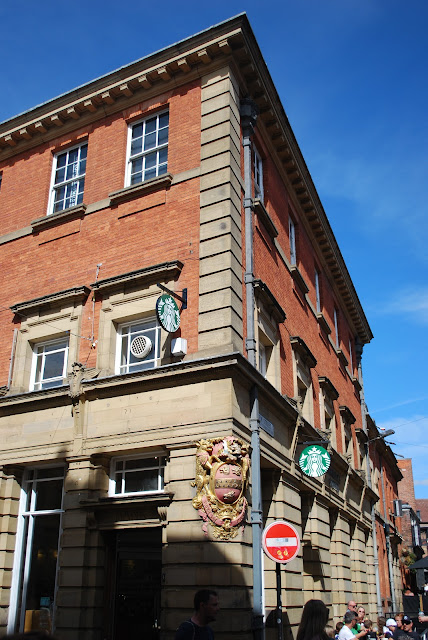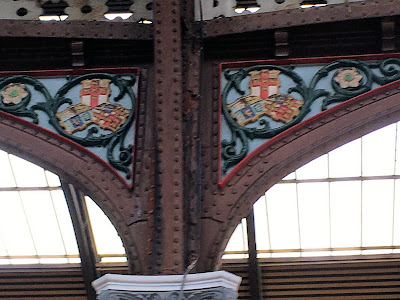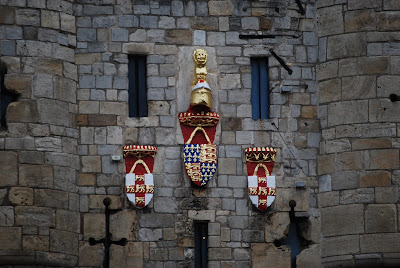On the corner of New Street and Coney Street in York sits the National Westminster Bank building (now home to a Starbucks with its own semi-heraldic logo of a crowned melusine). On the corner of that bank building is a full achievement of arms: Arms, two crests, motto, and supporters.
The history of this bank, and those arms, goes back to the very early 1800s, when Raper Swann Clough Swann Bland & Raper (Swann & Clough's Bank) moved to this location in 1810. They were taken over by Beckett & Co., an old Leeds family banking firm, in 1879. (Beckett & Co. was amalgamated with the Westminster Bank in 1920.)
In 1816, Sir Edmund Beckett, 4th Baronet, assumed the name and arms of Denison on succeeding to the baronetcy. He resumed the family name of Beckett in 1872.
Sir Edmund Beckett-Denison, 5th Baronet, was created Baron Grimthorpe in 1886. On his death in 1905, he was succeeded by his nephew, Ernest William Beckett-Denison, 2nd Baron Grimthorpe, and the senior partner in Beckett & Co.
So with all that as background, let us take a closer look at this achievement of arms (as always, you can click on the image below to see a larger, more detailed copy of this photograph), the arms of Ernest, 2nd Baron Grimthorpe:
So with all that as background, let us take a closer look at this achievement of arms (as always, you can click on the image below to see a larger, more detailed copy of this photograph), the arms of Ernest, 2nd Baron Grimthorpe:
The arms of Beckett, shown here, are blazoned: Gules a fess between three boar’s heads couped* erminois. There are two crests: 1, A sinister cubit arms in bend vested vert cuffed ermine charged on the sleeve with a cross crosslet or the hand proper with the forefinger pointing to an estoile radiated or (Denison); and 2, A boar's head couped or pierced by a cross paty fitchy erect gules (Beckett). The supporters on each side are: A boar erminois gorged with a collar gules pendant therefrom an escutcheon gules charged with a cross pay fitchy or. Below on a scroll is the motto: Prodesse civibus (To benefit my fellow citizens).
I cannot speak for everyone, not even other heraldry enthusiasts, but I personally find researching some of the stories behind these displays of armory to be fascinating. I had no idea when I first photographed this achievement of arms how involved the story of its origins and its placement on the corner of this building in York would turn out.
* I cannot resist adding this little ditty about heraldic boar's heads from C.W. Scott-Giles' Motley Heraldry here:
The boar's head couped in English fashion
Includes the neck--a generous ration;
In Scotland, when this charge appears
It's cut off close behind the ears;
But with the herald's wonted tact
I draw no moral from this fact.






































